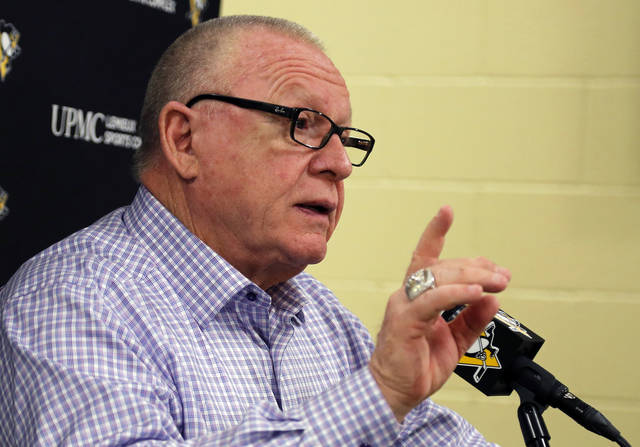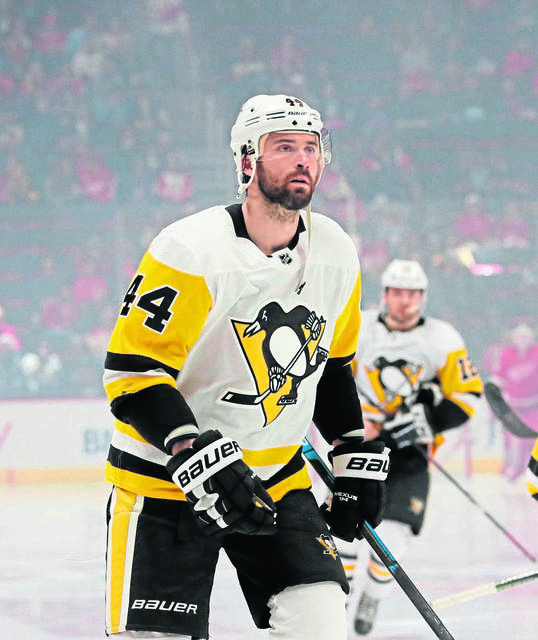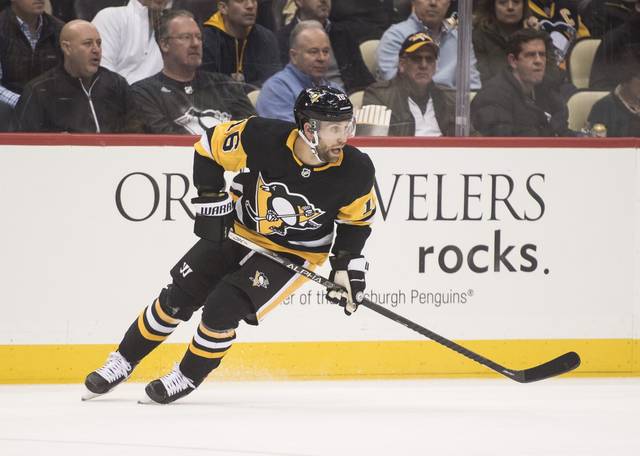In Jason Zucker deal, Penguins' Jim Rutherford sticks to trade tendency
Jim Rutherford wasn’t simply being optimistic. He was outright boastful.
The Pittsburgh Penguins general manager suggested his midseason acquisition could be a member of the franchise for more than half a decade.
“He’s coming into the prime of his career,” Rutherford said. “As long as the contract works out longterm and he fits here, he could be a good player here for a good six, seven years.”
Jason Zucker? No.
David Perron.
After acquiring Perron, a top-six winger, on Jan. 2, 2015, Rutherford spoke with reporters the next day and weighed the ramification of dealing the 2015 first-round draft pick to the Edmonton Oilers for a winger who was only 26 at the time.
As it turned out, Perron barely lasted one year when he was dealt Jan. 16, 2016, to the Anaheim Ducks in a deal that brought in forward Carl Hagelin, a player who was a major component in the franchise’s back-to-back Stanley Cup championships of 2016 and ’17.
But the Perron trade established a pattern for Rutherford that he maintained Monday when he acquired Zucker, another top-six winger, for a 2020 first-rounder and defensive prospect Calen Addison (to say nothing of disappointing forward Alex Galchenyuk).
Rutherford generally avoids true rental players when beefing up his roster as the trade deadline approaches. He more often will go after players who have time left on their contract or a pending restricted free agent before pursuing a player who is scheduled to become an unrestricted free agent in a handful of months.
Sure, he’s gone after the likes of forward Daniel Winnik or defenseman Ron Hainsey, players who had cups of coffee in Penguins jerseys before leaving via free agency. And the 2017 offseason deal to bring in pending unrestricted free agent enforcer Ryan Reaves from the St. Louis Blues in exchange for promising center Oskar Sundqvist and a 2017 first-round pick could be labeled as nothing but a failure.
But more often than not, when Rutherford deals a prospect or draft pick, he targets a player over whom he will have contract control.
There have been varying degrees of success with this approach. But Rutherford has been consistent with this modus operandi when it comes to deals in advance of the trade deadline.
Here’s a brief history of those trades:
David Perron
Date: Jan. 2, 2015
The trade: The Penguins acquired forward Perron from the Edmonton Oilers in exchange for forward Rob Klinkhammer and a 2015 first-round draft pick.
The contract: Perron was in the third year of a four-year contract with a salary-cap hit of $3,812,500 million.
The result: Perron showed some early flashes of his skilled brilliance with a respectable 22 points in 43 games with the Penguins in 2014-15. He never found any traction in 2015-16. Falling out of favor with new coach Mike Sullivan, he was dealt to the Ducks for Hagelin.
Carl Hagelin
Date: Jan. 16, 2016
The trade: The Penguins acquired Hagelin from the Anaheim Ducks in exchange for Perron and defenseman Adam Clendening.
The contract: Hagelin was in the first year of a four-year contract with a salary-cap hit of $4 million.
The result: Hagelin helped transform the Penguins into, arguably, the fastest team in the NHL as a key component of the famed HBK Line.
Derick Brassard
Date: Feb. 23, 2018
The trade: The Penguins acquired forward Brassard, defenseman Vincent Dunn and a 2018 third-round draft pick from the Ottawa Senators in exchange for defenseman Ian Cole, goaltender Filip Gustavsson, a 2018 first-round draft pick and a 2019 third-round draft pick. Additionally, the Penguins acquired forward Tobias Lindberg from the Vegas Golden Knights, who took on 40% of Brassard’s salary cap hit while also acquiring Reaves and a 2018 fourth-round draft pick from the Penguins.
The contract: Brassard was in Year 4 of a five-year contract with a salary-cap hit of $5 million.
The result: With designs of re-establishing the center depth that allowed the team to win consecutive Stanley Cup titles in 2016 and ’17, the Penguins hoped Brassard would be the perfect No. 3 center behind Sidney Crosby and Evgeni Malkin. He showed flashes of that while playing on a line with Phil Kessel, putting up eight points in 14 games. But a groin injury hobbled him late in the 2017-18 season. Entering 2018-19, he never seemed to embrace the prospect of playing an entire season as the third center and was moved in a multiplayer trade by February 2019.
Nick Bjugstad and Jared McCann
Date: Feb. 1, 2019
The trade: The Penguins acquired forwards Bjugstad and McCann from the Florida Panthers in exchange for Brassard, a 2019 second-round draft pick and two 2019 fourth-round draft picks.
The contracts: Bjugstad was in the fourth year of a six-year contract with a salary-cap hit of $4.1 million. McCann was in the first year of a two-year contract with a salary-cap hit of $1.25 million. He is a pending restricted free agent this offseason.
The result: McCann has been by far the most successful, and, not coincidentally, healthiest of the two. Blessed with versatility, he has been a left winger for Crosby and a second- or third-line center depending on other players’ well-being. This season, he is fifth on the team with 31 points (14 goals, 17 assists) in 53 games. Bjugstad showed some promise last season with 14 points, including nine goals, in 32 games with the Penguins while serving as the No. 3 center. But injuries have limited him to 10 games and one goal this season. His recovery from a core muscle injury he suffered Nov. 15 seemingly has regressed as he has not skated for several weeks.
Erik Gudbranson
Date: Feb. 25, 2019
The trade: The Penguins acquired defenseman Gudbranson from the Vancouver Canucks in exchange for forward Tanner Pearson.
The contract: Gudbranson was in the first year of a three-year contract with a salary-cap hit of $4 million.
The result: Gudbranson mainly was brought in because he was healthy, and the team was missing several defenseman at that time. A large presence at 6-foot-5, 217 pounds, he formed a third defensive pairing with Marcus Pettersson in the final months of 2018-19. With the emergence of rookie defenseman John Marino, the Penguins traded Gudbranson on Oct. 25 in order to become salary-cap compliant.
Jason Zucker
Date: Jan. 10, 2020
The trade: The Penguins acquired Zucker from the Wild in exchange for Addison, Galchenyuk and a conditional 2020 first-round draft pick that can be deferred to 2021 if the Penguins miss the playoffs this season.
The contract: Zucker is in Year 2 of a five-year contract with a salary-cap hit of $5.5 million.
The result: Zucker made his Penguins debut Tuesday in a 2-1 overtime loss to the Tampa Bay Lightning. Primarily playing on a line with Crosby, Zucker logged 15 minutes, 26 seconds on 20 shifts and recorded five shots on five attempts.
Seth Rorabaugh is a TribLive reporter covering the Pittsburgh Penguins. A North Huntingdon native, he joined the Trib in 2019 and has covered the Penguins since 2007. He can be reached at srorabaugh@triblive.com.
Remove the ads from your TribLIVE reading experience but still support the journalists who create the content with TribLIVE Ad-Free.







